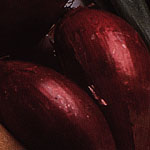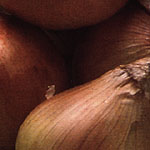


White / Yellow


FoodFood InformationVegetablesOnions
There are dozens of different varieties of bulb onions that come in a
wide range of sizes and shapes and in three flesh colors: yellow, white,
and red. All onions are similar in flavor, but some are sharp and others
are sweet.
Yellow onions are grown in many areas of the United States, with
Texas, California, Idaho, New York, and Michigan as the major producers.
In a calendar year the first onions to arrive in market are called new onions
and are usually of the Grano variety. They are harvested in April
and are grown in Texas, California, and Arizona. The Grano is flat-shaped
and has an almost colorless, paper-thin skin. It is very mild in flavor
and is one of our sweetest onions. Unlike the more hardy varieties that
arrive later in the year, the Grano is fairly perishable and purchases should
be limited to a few days supply. The Granos and the other early varieties
from Texas and California are in season from April until August.
The onions that arrive in market in August from the more northern states
(New York, the Pacific Northwestern states, and the Midwest) are called
globe onions. They are round rather than flat in shape, have copper-colored
parchment like skins, and are known as old onions. They are sharper than
the mild new onions.
When these globe onions are cured in proper storage in cool, well ventilated
areas, they have a shelf life of six to eight months. Carryovers of these
stored onions from the prior year's crop are available in moderate supply
when the first crop of new onions arrives in April. Since both crops overlap,
barring bad weather, onions are available twelve months of the year.
Just as there are two crops of yellow onions, there are two crops of white
onions. The first arrival of the white onions parallels that of the
new yellow onions. Most of the white onions are of varieties that produce
a very small bulb. They are primarily boiled and used in recipes that call
for creamed onions and are therefore called boilers. There are also
some very large white onions that are called white Spanish onions,
and they are used raw. Bermuda onions are the same as Spanish onions,
though they are not imported from Bermuda or Spain. Most are produced in
the United States and some are brought in from Chile.
The red-skinned, red-fleshed onions are known as red onions or Creole
onions. These are used primarily in salads. The early red onions are grown
in Texas and California. The later varieties are grown in New York and Michigan
and are also imported from Italy.
The mildness or the sharpness of an onion can't be determined by
its color or outward appearance, but rather by the variety and the area
in which it was produced. The seed used to grow large Spanish-type onions
in Idaho produces a sharper onion when produced in New York. This is also
true of the imported red Italian onions, which are sweeter than those grown
in Michigan or New York. However, the red onions grown in California and
Texas are quite mild in flavor and far less costly than those imported from
Italy.
In recent years there has been a PR battle waged in newspapers and magazines
as to which area grows the sweetest, mildest onions. The main participants
in this contest are the Vidalia onions grown in Georgia, the Maui
onions grown in Hawaii, and the Walla Walla onions grown in Washington
State. All three are fine products of comparable quality and flavor, and
they usually sell at premium prices. But the less-heralded onions grown
in Texas, California, and some of the northwestern states are almost if
not just as sweet and mild as those and a lot less costly.
Look for very firm, dry, well-shaped onions that are almost free from odor
and completely free from sprouting. Softness at the neck (the top) of the
onion is a dead giveaway as to impending or actual decay. Store onions in
a cool, dry area.





Deamer 5/97